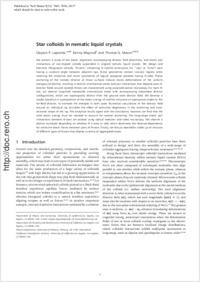Star colloids in nematic liquid crystals
- Lapointe, Clayton P. Department of Physics and Astronomy, University of California-Los Angeles, USA - Department of Chemistry and Biochemistry, University of California-Los Angeles, USA - Physics Department, University of Fribourg, Switzerland
- Mayor, Kenny Department of Physics and Astronomy, University of California-Los Angeles, USA - Department of Chemistry and Biochemistry, University of California-Los Angeles, USA
- Mason, Thomas G. Department of Physics and Astronomy, University of California-Los Angeles, USA - Department of Chemistry and Biochemistry, University of California-Los Angeles, USA - California NanoSystems Institute, University of California-Los Angeles, USA
-
24.07.2013
Published in:
- Soft Matter. - 2013, vol. 9, no. 32, p. 7843–7854
English
We present a study of the elastic alignment, accompanying director field distortions, and elastic pair interactions of star-shaped colloids suspended in aligned nematic liquid crystals. We design and fabricate lithographic colloids, “N-stars”, containing N rod-like protrusions (i.e. “rays” or “arms”) each having a constant angle between adjacent rays. N-star geometries contain concave regions while retaining the rotational and mirror symmetries of regular polygonal platelets having N sides. Planar anchoring of the nematic director at N-star surfaces induces elastic deformations of the uniform background director, resulting in distinct orientational states and pair interactions that depend upon N. Director fields around isolated N-stars are characterized using polarized optical microscopy. For each N-star, we observe long-lived metastable orientational states with accompanying metastable director configurations, which are topologically distinct from the ground state director field. We develop a model, based on a superposition of the elastic energy of rod-like inclusions at appropriate angles to the far-field director, to estimate the energies in both cases. Numerical calculations of the director field around an individual ray elucidate the effect of azimuthal degeneracy in the anchoring and cross-sectional shape of the ray. The analytical results agree with the simulations, however, we find that the total elastic energy must be rescaled to account for weaker anchoring. The long-range elastic pair interactions between N-stars are probed using optical tweezers and video microscopy. We observe a distinct multipole depending on whether N is even or odd, which dominates the distance-dependence for attractive elastic forces between pairs of N-stars. Finally, we discuss assemblies made up of mixtures of different types of N-stars that display a variety of aggregated states.
- Faculty
- Faculté des sciences et de médecine
- Department
- Département de Physique
- Language
-
- English
- Classification
- Physics
- License
-
License undefined
- Identifiers
-
- RERO DOC 136728
- DOI 10.1039/C3SM51303C
- Persistent URL
- https://folia.unifr.ch/unifr/documents/303171
Statistics
Document views: 94
File downloads:
- pdf: 246
